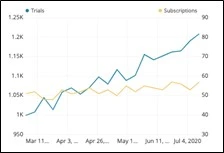Are you curious about the stock market, but feel intimidated by all the jargon and numbers?
Fear not, as this article about understanding stocks for dummies is here to help you understand the basics of reading stocks in a simple and straightforward way.
Whether you’re a complete beginner or just need a refresher, this guide will break down the key concepts of stock market analysis into easy-to-understand terms.
By the end, you’ll be equipped with the knowledge to confidently navigate the world of stocks and potentially make investment decisions.
So, sit back, relax, and let’s dive into the world of stocks together with this guide about understanding stocks for dummies!
What Is A Stock Chart?
A stock chart is a visual representation of a stock’s price movement over a specific period of time. It is a powerful tool for investors and traders to analyze the performance of a particular stock or market as a whole.
Let’s take review of different types of charts and the importance of how to read stock charts.
Types Of Stock Charts
There are several types of stock charts available, including line charts, bar charts, and candlestick charts. Each type of chart presents price information differently, with some providing more detail than others.
Line Charts
Line charts are the simplest type of stock chart, presenting a basic representation of a stock’s price movement over time.

They are created by connecting the closing prices of a stock with a straight line, making them useful for identifying overall trends in the market.
Bar Charts
Bar charts provide more information than line charts, presenting the open, high, low, and close prices of a stock over a specific time period.

Each bar represents a single trading day, with the high and low points represented by vertical lines and the open and close prices represented by horizontal lines.
Candlestick Charts
Candlestick charts are similar to bar charts but provide more detail about a stock’s price movement.

They are created by combining the open, high, low, and close prices of a stock into a single candlestick shape, making it easier to identify patterns and trends in the market.
Why Stock Charts Are Important
Stock charts are like pictures that show how a stock has performed over time. They are very important for people who want to start stock trading.
Stock charts can help how to read stocks for dummies enabling them to make good decisions about which stocks to buy and when to sell them.
By learning how to read stock charts and about different types, new to stock trading can understand more about how individual stocks are doing and how the whole stock market is doing.
This is useful for people who are new to investing.
Understanding Stocks For Dummies
Stocks are a good way to grow your wealth over time. In spite of this, understanding stocks for dummies can be overwhelming and confusing.
Here are some essential things to understand how to read stocks for dummies before they start investing in stocks.
-
What Are Stocks?
Stocks represent ownership in a company. When you buy a share of stock, you become a part-owner of that company and have a right to a portion of the company’s earnings and assets.
The value of your stock increases or decreases based on the performance of the company.
-
Types Of Stocks
There are two main types of stocks: common stocks and preferred stocks. Common stocks offer voting rights and are the most common type of stock. Preferred stocks do not offer voting rights but offer a fixed dividend payment.
-
How To Buy Stocks
To buy stocks, you will need to open a brokerage account. Online brokers offer a convenient and affordable way to buy and sell stocks.

Once you have opened an account, you can start buying stocks by placing an order through your broker.
-
Diversification
Investing in multiple stocks helps to reduce the risk of losses. This is called diversification. By investing in a variety of stocks across different industries and sectors, you can spread out your risk.
-
The Stock Market
The stock market is where stocks are bought and sold. The most well-known stock exchange is the New York Stock Exchange (NYSE).
Other exchanges include NASDAQ, the London Stock Exchange, and the Tokyo Stock Exchange.
How To Read Stocks For Dummies
Understanding stocks for dummies can be inspiring; however, it is an essential skill to learn for anyone interested in investing in the stock market.
-
Stock Ticker Symbol
Each company listed on the stock market has a unique ticker symbol. This symbol is a series of letters that represents the company. Ticker symbols are used to identify stocks when trading.
-
Stock Price
The stock price is the amount that an individual stock is worth. This price is determined by the supply and demand for the stock.
If there are more buyers than sellers, the price will go up, and if there are more sellers than buyers, the price will go down.
-
Stock Market Indexes
A stock market index is a measure of the performance of a group of stocks. Examples of stock market indexes include the S&P 500 and the Dow Jones Industrial Average.
These indexes give investors an idea of how the overall stock market is performing.
-
Understanding Stock Performance Metrics
There are several metrics that investors use to evaluate a stock’s performance. These include earnings per share (EPS), the price-to-earnings ratio (P/E ratio), and dividend yield.
EPS measures a company’s profitability, the P/E ratio compares a stock’s price to its earnings, and dividend yield represents the annual dividend payments as a percentage of the stock’s price.
-
Analyzing Company Financials
Investors should also analyze a company’s financial statements to gain a better understanding of its financial health.
The income statement, balance sheet, and cash flow statement provide insights into a company’s revenue, expenses, assets, and liabilities.
Key Metrics For Analyzing Stocks
Key metrics are crucial for analyzing stocks as they provide valuable insights into a company’s financial health and performance.

Metrics like earnings per share, price-to-earnings ratio, and return on investment help investors assess profitability, valuation, and efficiency.
Understanding these metrics about how to read stocks for dummies enables them to make sound investment decisions and minimizes risk by identifying promising investment opportunities.
-
Price-To-Earnings (P/E) Ratio
The Price-to-Earnings (P/E) ratio is a fundamental metric used by investors to assess the valuation of a stock. It measures the relationship between the price of a stock and its earnings per share (EPS).
A high P/E ratio indicates that the market has high expectations for the company’s future earnings growth, while a low P/E ratio suggests that the stock may be undervalued.
By comparing the P/E ratio of a stock to its industry peers or historical averages, investors can gain insights into its relative value and growth prospects.
-
Earnings Per Share (EPS)
Earnings per Share (EPS) is another crucial metric that provides a glimpse into a company’s profitability and financial performance.
EPS represents the portion of a company’s profit allocated to each outstanding share of common stock. It serves as an indicator of the company’s ability to generate earnings for its shareholders.
Increasing EPS over time suggests that the company is growing and becoming more profitable.
Investors often compare a company’s EPS to its competitors and industry benchmarks to gauge its financial health and profitability potential.
-
Dividend Yield
Dividend yield is a metric that indicates the return on investment through dividend payments. It is calculated by dividing the annual dividend per share by the stock’s current price.
Dividend yield is particularly important for income-focused investors who seek regular cash flows from their investments.
A high dividend yield may indicate that the stock is undervalued or that the company has a stable and reliable dividend policy.
However, it’s important to consider other factors, such as the company’s financial health and sustainability of dividend payments, before making investment decisions solely based on dividend yield.
-
Return On Investment (ROI)
Return on Investment (ROI) measures the profitability of an investment by comparing the gain or loss generated relative to the cost of the investment.
It is calculated by dividing the net profit from an investment by the initial investment cost and expressing it as a percentage. ROI provides insights into the efficiency and effectiveness of an investment.
A high ROI suggests that an investment has been successful, while a low ROI may indicate poor performance.
Investors can use ROI to evaluate the attractiveness of different investment options and assess the historical performance of stocks in their portfolios.
Stock Market Investing For Dummies
Stock market investing for dummies can be a fearsome task, but it doesn’t have to be. With the right knowledge and guidance, anyone can start investing and potentially earn significant returns.
-
Understanding The Basics
The first step towards how to read stocks for dummies in stock market investing is to understand the basics. This includes the different types of stocks, the risks involved, and the importance of diversification.
Stock market investing for dummies requires them to do research and familiarize themselves with the market before investing their hard-earned money.
-
Choosing The Right Stocks
Once you have a good understanding of the basics, it’s time to start choosing the right stocks to invest in.
This can be a tricky process, but there are several factors to consider, such as the company’s financials, industry trends, and potential for growth.
-
Timing Is Everything
Timing is also an important factor in stock market investing. Knowing when to buy and sell stocks can make a big difference in your returns.
It’s essential to stay up-to-date on market news and trends to make critical decisions about your investments.
-
Getting Started
If you’re ready to start investing in the stock market, there are several ways to get started. You can open a brokerage account, work with a financial advisor, or even invest in index funds or exchange-traded funds (ETFs).
Getting Started in The Stock Market
Getting started in the stock market can be daunting, but with a few key steps, it becomes more manageable.
Begin by educating yourself on basic concepts and terminology. Create a budget and set clear investment goals.
Open a brokerage account and research potential stocks. Start with small investments and gradually increase as you gain confidence and experience. Regularly monitor and evaluate your portfolio to make informed decisions.
-
Goals And Objectives
When venturing into the stock market, individuals must establish their goals and objectives.
These can include long-term wealth accumulation, retirement planning, or funding a specific financial goal. By defining their purpose, investors can tailor their strategies and risk tolerance accordingly.
-
Understanding Financial Markets
Before diving into stock market investments, one must have a basic understanding of financial markets. This entails learning about stocks, bonds, exchange-traded funds (ETFs), and other investment vehicles.
Familiarity with key financial indicators, such as price-to-earnings ratios and market trends, is also essential.

-
Money Into Stocks: Strategies For Smart Investment
To make smart investment decisions, it is crucial to adopt effective strategies.
This involves conducting thorough research, analyzing company fundamentals, and considering market conditions. Strategies may include value investing, growth investing, or dividend investing.
Additionally, investors should employ techniques like dollar-cost averaging or setting stop-loss orders to manage risk.
-
Diversified Portfolio: Building A Solid Portfolio
Building a diversified portfolio is crucial for mitigating risk. Investors should allocate their funds across various industries, sectors, and asset classes.
This helps balance potential losses and gains, reducing vulnerability to market fluctuations. Diversification can be achieved through investing in different stocks, bonds, mutual funds, or ETFs.
-
Expert Info: Gaining Professional Insight Into Investing Strategies
Gaining professional insight and guidance can enhance investment decisions. Investors can seek advice from financial advisors, read books by renowned investors, or follow reputable financial news sources.
Staying updated with the latest market trends and strategies can help make informed choices and potentially maximize returns.
Reading The Market Trends
Reading market trends is essential for businesses to stay competitive and make informed decisions. It involves analyzing consumer behavior, economic indicators, and industry developments.
By monitoring market trends, businesses can identify emerging opportunities, adapt their strategies, and mitigate risks. It helps them stay ahead of the curve and navigate the ever-changing business landscape.

Introduction To Stock Investing
When it comes to investing in stocks, understanding market trends is essential for making informed decisions. Market trends reflect the collective sentiment of investors and can greatly influence stock prices.
Successful investors develop the ability to read these trends to identify potential opportunities and risks.
Categories Of Stocks: Different Types And Their Level Of Risk
When it comes to investing in stocks, understanding the different categories and their associated level of risk is crucial. Stocks can be categorized based on their size, industry, and growth potential.
Here, we explore the major types of stocks and provide a brief overview of their risk profiles.
| Category | Description | Level of Risk |
| Blue-Chip | Stocks of large, well-established companies like Microsoft Corp. (NASDAQ: MSFT), Walmart Inc. (NYSE: WMT), Visa Inc. (NYSE: V), Tesla, Inc. (NASDAQ: TSLA), The Coca-Cola Company (NYSE: KO), and Chevron Corp. (NYSE: CVX) | Low to moderate risk |
| Growth | Stocks of companies with high growth potential | Moderate to high risk |
| Value | Stocks considered undervalued by market | Moderate to high risk |
| Dividend | Stocks that pay regular dividends to shareholders | Low to moderate risk |
| Small-Cap | Stocks of small, emerging companies | High risk |
| Mid-Cap | Stocks of medium-sized companies | Moderate to high risk |
| Large-Cap | Stocks of large, stable companies | Low to moderate risk |
| Cyclical | Stocks of companies sensitive to economic cycles | Moderate to high risk |
| Defensive | Stocks of companies that perform well in downturns | Low to moderate risk |
| Technology | Stocks of technology-focused companies | Moderate to high risk |
Penny Stocks: A Word Of Caution
Penny stocks, commonly traded at low prices, can be enticing to investors seeking quick gains. However, they are highly speculative and carry substantial risks.
Due diligence and thorough research are crucial when considering penny stocks, as they often lack the liquidity and regulatory oversight found in larger stocks. Some
Stock Price, Charts, And Annual Reports
Analyzing stock prices, charts, and annual reports provides valuable insights into market trends. Price movements and technical indicators on charts can reveal patterns and trends, aiding in decision-making.
Annual reports provide detailed financial information about a company’s performance, including revenue, expenses, and future projections.
By studying these reports, investors can gain a deeper understanding of a company’s financial health and make more informed investment decisions.
Best Stock Trading Tools
For those looking to invest in the stock market, having the right tools is essential. Here are some of the best stock trading tools available today:
-
Trading Platforms
A reliable trading platform is a must-have tool for any stock trader. Popular options include MetaTrader 4, thinkorswim, and TradingView.
-
Stock Screeners
These tools allow traders to filter through stocks based on specific criteria, such as price, sector, and volume. Some of the most popular stock screeners include Finviz and Yahoo Finance.
-
News And Research Sources
Keeping up-to-date with market news and trends is crucial for making smarter trading decisions. Traders can use platforms such as Bloomberg, CNBC, and Seeking Alpha to stay informed.
-
Charting Software
Charting software is essential for technical analysis, allowing traders to visualize stock price movements and identify patterns. Options include TradingView and MetaTrader 4.
-
Mobile Apps
For traders on the go, mobile trading apps such as Robinhood and E-Trade offer convenient access to stock trading and account management.
By utilizing these tools, traders can enhance their investment strategies and increase their chances of success in the stock market.
Conclusion
With the right resources and approach to this article about how to read stocks for dummies, even beginners can develop the skills to interpret market trends and make efficient moves.
Whether you’re interested in buying individual stocks or investing in mutual funds, understanding market trends is critical to success.
By starting with the basics, like understanding stock prices and market capitalization, and gradually building your knowledge of technical analysis and fundamental indicators, you can become a savvy investor in no time.
FAQs
What Are Common Stock Trend Lines?
Common stock trend lines are graphical representations of a stock’s price movement over a specific period.
These lines help investors identify patterns and trends, such as support and resistance levels and can aid in making crucial decisions.
By analyzing these trend lines, investors can gain insight into the stock’s momentum and potentially anticipate future price movements.
Which Indicator is Best for the Trend Line?
A trend line is an important tool in technical analysis, and selecting the right indicator to use with it can make a significant difference in the accuracy of predictions.
One of the best indicators to use with the trend line is the moving average, which smoothes out fluctuations in price and helps identify trends more easily.
By using the moving average in conjunction with the trend line, traders can make more informed decisions about when to enter or exit a position.
What is a Perfect Trend Line?
A perfect trend line is a line that connects a series of data points in a way that best represents the overall trend of the data.
It is a powerful tool for visualizing and analyzing data patterns, as it helps to identify trends, patterns, and potential areas of support or resistance.
When plotted correctly, a perfect trend line can provide valuable insights into future market movements, making it an essential tool for investors and traders alike.











